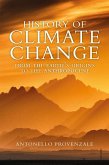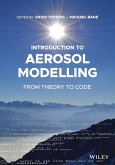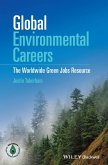M. A. K. Khalil (Portland State University)
Global Climate Change and Human Life
M. A. K. Khalil (Portland State University)
Global Climate Change and Human Life
- Broschiertes Buch
- Merkliste
- Auf die Merkliste
- Bewerten Bewerten
- Teilen
- Produkt teilen
- Produkterinnerung
- Produkterinnerung
How warm will the Earth become and when? What effect will it have on human life? This book answers some of these questions, providing facts and theories that will help you to formulate rational opinions and gain a new way to think about the complexities of the subject and the future of the global environment and climate.
Andere Kunden interessierten sich auch für
![Fast Processes in Large-Scale Atmospheric Models Fast Processes in Large-Scale Atmospheric Models]() Fast Processes in Large-Scale Atmospheric Models211,99 €
Fast Processes in Large-Scale Atmospheric Models211,99 €![History of Climate Change History of Climate Change]() Antonello ProvenzaleHistory of Climate Change32,99 €
Antonello ProvenzaleHistory of Climate Change32,99 €![Climate and Society Climate and Society]() Robin Leichenko (State University of New Jersey)Climate and Society77,99 €
Robin Leichenko (State University of New Jersey)Climate and Society77,99 €![Introduction to Aerosol Modelling Introduction to Aerosol Modelling]() Introduction to Aerosol Modelling123,99 €
Introduction to Aerosol Modelling123,99 €![Sustainability Sustainability]() Leslie Paul Thiele (University of Florida, Gainesville, FL)Sustainability65,99 €
Leslie Paul Thiele (University of Florida, Gainesville, FL)Sustainability65,99 €![Daily Energy Use and Carbon Emissions Daily Energy Use and Carbon Emissions]() Bruce E. Logan (University Park The Pennsylvania State University)Daily Energy Use and Carbon Emissions87,99 €
Bruce E. Logan (University Park The Pennsylvania State University)Daily Energy Use and Carbon Emissions87,99 €![Global Environmental Careers Global Environmental Careers]() Justin TaberhamGlobal Environmental Careers50,99 €
Justin TaberhamGlobal Environmental Careers50,99 €-
-
-
How warm will the Earth become and when? What effect will it have on human life? This book answers some of these questions, providing facts and theories that will help you to formulate rational opinions and gain a new way to think about the complexities of the subject and the future of the global environment and climate.
Produktdetails
- Produktdetails
- Verlag: American Geophysical Union / Wiley & Sons
- Artikelnr. des Verlages: 14566578000
- 1. Auflage
- Seitenzahl: 288
- Erscheinungstermin: 30. Juni 2022
- Englisch
- Abmessung: 252mm x 200mm x 16mm
- Gewicht: 692g
- ISBN-13: 9780470665787
- ISBN-10: 0470665785
- Artikelnr.: 42434609
- Herstellerkennzeichnung
- Libri GmbH
- Europaallee 1
- 36244 Bad Hersfeld
- gpsr@libri.de
- Verlag: American Geophysical Union / Wiley & Sons
- Artikelnr. des Verlages: 14566578000
- 1. Auflage
- Seitenzahl: 288
- Erscheinungstermin: 30. Juni 2022
- Englisch
- Abmessung: 252mm x 200mm x 16mm
- Gewicht: 692g
- ISBN-13: 9780470665787
- ISBN-10: 0470665785
- Artikelnr.: 42434609
- Herstellerkennzeichnung
- Libri GmbH
- Europaallee 1
- 36244 Bad Hersfeld
- gpsr@libri.de
About the Author M. A. K. Khalil is Professor of Physics at Portland State University, USA. He holds BA degrees in Mathematics and Psychology and a Bachelor of Physics degree from the University of Minnesota; MS in Physics from Virginia Polytechnic Institute; PhD in Theoretical Physics from the Center For Particle Theory, University of Texas, and a PhD in Environmental Science and Engineering from OGC, now Oregon Health and Sciences University. He has published more than 200 papers in the environmental sciences and theoretical physics, and was named one of the world's most highly cited authors by ISI.
Preface ix
About the Companion Website xi
1 Introduction 1
1.1 What Is Global Change Science? 1
1.2 Current Global Change 2
1.3 Raising Fundamental Questions 2
Endnotes 3
2 The Framework 5
2.1 The System 5
2.2 Scales of Action 5
2.3 What Determines Climate? 8
2.4 The Benchmark Average Climate 12
2.5 Irreducible Uncertainties 15
2.6 The Plan 16
Review of the Main Points 18
3 Atmospheric Composition 19
3.1 Trace Gases and Their Roles in Climate and the Environment 19
3.2 Quantifying the Atmospheric Composition 22
Review of the Main Points 27
Endnotes 29
4 Mass Balance Theory and Small Models 33
4.1 The Components 33
4.2 Global 35
4.3 Hemispherical and Horizontal 40
4.4 Vertical 43
Review of the Main Points 46
Endnotes 48
5 Transport Processes 51
5.1 Vertical Transport and Convection 51
5.2 Horizontal Motion and the General Circulation 56
5.3 Turbulent Transport 61
5.4 Quantifying Transport Processes 66
Review of the Main Points 69
Endnotes 70
6 Mechanisms of Sources and Sinks 73
6.1 Reservoirs and Source-Sink Relationships 74
6.2 Atmospheric Chemistry 77
6.3 Global Environmental Applications 82
6.4 Cross-Media Transport: Oceans, Soils, and Biota 90
Review of the Main Points 100
Endnotes 102
7 Balance of Climate Gases and Aerosols 107
7.1 Anthropogenic vs Natural Components 107
7.2 Greenhouse Gases 110
7.3 Aerosols 123
Review of the Main Points 126
Endnotes 127
8 The Science of Climate 131
8.1 Solar Radiation 131
8.2 Albedo 135
8.3 Radiative Transfer 137
8.4 Heat Storage and Balance 150
8.5 Precipitation 152
Review of the Main Points 154
Endnotes 156
9 Instructive Climate Models 159
9.1 Base Temperature Model - Lessons, Flaws, and Resolution 159
9.2 Radiative Forcing and Climate Sensitivity 166
9.3 Practical Relationships between Greenhouse Gases and Surface Warming 168
9.4 Role of the Oceans 171
9.5 Role of Clouds 174
9.6 Horizontal Transport of Heat 175
Review of the Main Points 178
Endnotes 180
10 Climate Feedbacks 183
10.1 How They Work 183
10.2 Feedbacks Classified and Delineated 188
10.3 Physical Feedbacks 189
10.4 Role of the Living World 192
Review of the Main Points 197
Endnotes 199
11 Match of Climate Change Observed and Modeled 201
11.1 What Is Global Warming? 201
11.2 Causes of Observed Warming 204
11.3 Differential Effects of Climate Change 207
Review of the Main Points 210
Endnotes 210
12 Population, Affluence, and Global Change 213
12.1 Basic Relationships 213
12.2 Societal Factors in Climate Change 215
12.3 Population Growth and Resources 218
12.4 Vulnerability Theory 222
Review of the Main Points 225
Endnotes 226
13 Impacts of Climate Change on Human Life 229
13.1 Impacts Classified 229
13.2 Health 230
13.3 Habitability 234
Review of the Main Points 239
Endnotes 240
14 Climate Management 243
14.1 Tragedy of the Commons 243
14.2 Compounding
About the Companion Website xi
1 Introduction 1
1.1 What Is Global Change Science? 1
1.2 Current Global Change 2
1.3 Raising Fundamental Questions 2
Endnotes 3
2 The Framework 5
2.1 The System 5
2.2 Scales of Action 5
2.3 What Determines Climate? 8
2.4 The Benchmark Average Climate 12
2.5 Irreducible Uncertainties 15
2.6 The Plan 16
Review of the Main Points 18
3 Atmospheric Composition 19
3.1 Trace Gases and Their Roles in Climate and the Environment 19
3.2 Quantifying the Atmospheric Composition 22
Review of the Main Points 27
Endnotes 29
4 Mass Balance Theory and Small Models 33
4.1 The Components 33
4.2 Global 35
4.3 Hemispherical and Horizontal 40
4.4 Vertical 43
Review of the Main Points 46
Endnotes 48
5 Transport Processes 51
5.1 Vertical Transport and Convection 51
5.2 Horizontal Motion and the General Circulation 56
5.3 Turbulent Transport 61
5.4 Quantifying Transport Processes 66
Review of the Main Points 69
Endnotes 70
6 Mechanisms of Sources and Sinks 73
6.1 Reservoirs and Source-Sink Relationships 74
6.2 Atmospheric Chemistry 77
6.3 Global Environmental Applications 82
6.4 Cross-Media Transport: Oceans, Soils, and Biota 90
Review of the Main Points 100
Endnotes 102
7 Balance of Climate Gases and Aerosols 107
7.1 Anthropogenic vs Natural Components 107
7.2 Greenhouse Gases 110
7.3 Aerosols 123
Review of the Main Points 126
Endnotes 127
8 The Science of Climate 131
8.1 Solar Radiation 131
8.2 Albedo 135
8.3 Radiative Transfer 137
8.4 Heat Storage and Balance 150
8.5 Precipitation 152
Review of the Main Points 154
Endnotes 156
9 Instructive Climate Models 159
9.1 Base Temperature Model - Lessons, Flaws, and Resolution 159
9.2 Radiative Forcing and Climate Sensitivity 166
9.3 Practical Relationships between Greenhouse Gases and Surface Warming 168
9.4 Role of the Oceans 171
9.5 Role of Clouds 174
9.6 Horizontal Transport of Heat 175
Review of the Main Points 178
Endnotes 180
10 Climate Feedbacks 183
10.1 How They Work 183
10.2 Feedbacks Classified and Delineated 188
10.3 Physical Feedbacks 189
10.4 Role of the Living World 192
Review of the Main Points 197
Endnotes 199
11 Match of Climate Change Observed and Modeled 201
11.1 What Is Global Warming? 201
11.2 Causes of Observed Warming 204
11.3 Differential Effects of Climate Change 207
Review of the Main Points 210
Endnotes 210
12 Population, Affluence, and Global Change 213
12.1 Basic Relationships 213
12.2 Societal Factors in Climate Change 215
12.3 Population Growth and Resources 218
12.4 Vulnerability Theory 222
Review of the Main Points 225
Endnotes 226
13 Impacts of Climate Change on Human Life 229
13.1 Impacts Classified 229
13.2 Health 230
13.3 Habitability 234
Review of the Main Points 239
Endnotes 240
14 Climate Management 243
14.1 Tragedy of the Commons 243
14.2 Compounding
Preface ix
About the Companion Website xi
1 Introduction 1
1.1 What Is Global Change Science? 1
1.2 Current Global Change 2
1.3 Raising Fundamental Questions 2
Endnotes 3
2 The Framework 5
2.1 The System 5
2.2 Scales of Action 5
2.3 What Determines Climate? 8
2.4 The Benchmark Average Climate 12
2.5 Irreducible Uncertainties 15
2.6 The Plan 16
Review of the Main Points 18
3 Atmospheric Composition 19
3.1 Trace Gases and Their Roles in Climate and the Environment 19
3.2 Quantifying the Atmospheric Composition 22
Review of the Main Points 27
Endnotes 29
4 Mass Balance Theory and Small Models 33
4.1 The Components 33
4.2 Global 35
4.3 Hemispherical and Horizontal 40
4.4 Vertical 43
Review of the Main Points 46
Endnotes 48
5 Transport Processes 51
5.1 Vertical Transport and Convection 51
5.2 Horizontal Motion and the General Circulation 56
5.3 Turbulent Transport 61
5.4 Quantifying Transport Processes 66
Review of the Main Points 69
Endnotes 70
6 Mechanisms of Sources and Sinks 73
6.1 Reservoirs and Source-Sink Relationships 74
6.2 Atmospheric Chemistry 77
6.3 Global Environmental Applications 82
6.4 Cross-Media Transport: Oceans, Soils, and Biota 90
Review of the Main Points 100
Endnotes 102
7 Balance of Climate Gases and Aerosols 107
7.1 Anthropogenic vs Natural Components 107
7.2 Greenhouse Gases 110
7.3 Aerosols 123
Review of the Main Points 126
Endnotes 127
8 The Science of Climate 131
8.1 Solar Radiation 131
8.2 Albedo 135
8.3 Radiative Transfer 137
8.4 Heat Storage and Balance 150
8.5 Precipitation 152
Review of the Main Points 154
Endnotes 156
9 Instructive Climate Models 159
9.1 Base Temperature Model - Lessons, Flaws, and Resolution 159
9.2 Radiative Forcing and Climate Sensitivity 166
9.3 Practical Relationships between Greenhouse Gases and Surface Warming 168
9.4 Role of the Oceans 171
9.5 Role of Clouds 174
9.6 Horizontal Transport of Heat 175
Review of the Main Points 178
Endnotes 180
10 Climate Feedbacks 183
10.1 How They Work 183
10.2 Feedbacks Classified and Delineated 188
10.3 Physical Feedbacks 189
10.4 Role of the Living World 192
Review of the Main Points 197
Endnotes 199
11 Match of Climate Change Observed and Modeled 201
11.1 What Is Global Warming? 201
11.2 Causes of Observed Warming 204
11.3 Differential Effects of Climate Change 207
Review of the Main Points 210
Endnotes 210
12 Population, Affluence, and Global Change 213
12.1 Basic Relationships 213
12.2 Societal Factors in Climate Change 215
12.3 Population Growth and Resources 218
12.4 Vulnerability Theory 222
Review of the Main Points 225
Endnotes 226
13 Impacts of Climate Change on Human Life 229
13.1 Impacts Classified 229
13.2 Health 230
13.3 Habitability 234
Review of the Main Points 239
Endnotes 240
14 Climate Management 243
14.1 Tragedy of the Commons 243
14.2 Compounding
About the Companion Website xi
1 Introduction 1
1.1 What Is Global Change Science? 1
1.2 Current Global Change 2
1.3 Raising Fundamental Questions 2
Endnotes 3
2 The Framework 5
2.1 The System 5
2.2 Scales of Action 5
2.3 What Determines Climate? 8
2.4 The Benchmark Average Climate 12
2.5 Irreducible Uncertainties 15
2.6 The Plan 16
Review of the Main Points 18
3 Atmospheric Composition 19
3.1 Trace Gases and Their Roles in Climate and the Environment 19
3.2 Quantifying the Atmospheric Composition 22
Review of the Main Points 27
Endnotes 29
4 Mass Balance Theory and Small Models 33
4.1 The Components 33
4.2 Global 35
4.3 Hemispherical and Horizontal 40
4.4 Vertical 43
Review of the Main Points 46
Endnotes 48
5 Transport Processes 51
5.1 Vertical Transport and Convection 51
5.2 Horizontal Motion and the General Circulation 56
5.3 Turbulent Transport 61
5.4 Quantifying Transport Processes 66
Review of the Main Points 69
Endnotes 70
6 Mechanisms of Sources and Sinks 73
6.1 Reservoirs and Source-Sink Relationships 74
6.2 Atmospheric Chemistry 77
6.3 Global Environmental Applications 82
6.4 Cross-Media Transport: Oceans, Soils, and Biota 90
Review of the Main Points 100
Endnotes 102
7 Balance of Climate Gases and Aerosols 107
7.1 Anthropogenic vs Natural Components 107
7.2 Greenhouse Gases 110
7.3 Aerosols 123
Review of the Main Points 126
Endnotes 127
8 The Science of Climate 131
8.1 Solar Radiation 131
8.2 Albedo 135
8.3 Radiative Transfer 137
8.4 Heat Storage and Balance 150
8.5 Precipitation 152
Review of the Main Points 154
Endnotes 156
9 Instructive Climate Models 159
9.1 Base Temperature Model - Lessons, Flaws, and Resolution 159
9.2 Radiative Forcing and Climate Sensitivity 166
9.3 Practical Relationships between Greenhouse Gases and Surface Warming 168
9.4 Role of the Oceans 171
9.5 Role of Clouds 174
9.6 Horizontal Transport of Heat 175
Review of the Main Points 178
Endnotes 180
10 Climate Feedbacks 183
10.1 How They Work 183
10.2 Feedbacks Classified and Delineated 188
10.3 Physical Feedbacks 189
10.4 Role of the Living World 192
Review of the Main Points 197
Endnotes 199
11 Match of Climate Change Observed and Modeled 201
11.1 What Is Global Warming? 201
11.2 Causes of Observed Warming 204
11.3 Differential Effects of Climate Change 207
Review of the Main Points 210
Endnotes 210
12 Population, Affluence, and Global Change 213
12.1 Basic Relationships 213
12.2 Societal Factors in Climate Change 215
12.3 Population Growth and Resources 218
12.4 Vulnerability Theory 222
Review of the Main Points 225
Endnotes 226
13 Impacts of Climate Change on Human Life 229
13.1 Impacts Classified 229
13.2 Health 230
13.3 Habitability 234
Review of the Main Points 239
Endnotes 240
14 Climate Management 243
14.1 Tragedy of the Commons 243
14.2 Compounding








